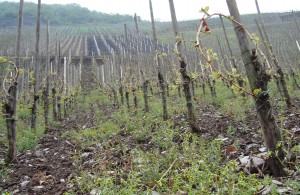Want to invest in vineyards?

The current Fall 2009 special edition of Wine & Spirits Magazine features a story on “Best Land to Grab” highlighting five lesser known areas that have potential to grow fine wine grapes, from England’s limestone coast to the Istria Peninsula in the Adriatic. But what about investing in a classic wine region that produces world benchmark rieslings? That would be the Mosel wine region in Germany. The production costs are high, but the vineyard land is cheap.
Production costs are high due to the steep vineyard slopes of the Mosel some up to 65-70 degrees. Much of the work must be done by hand because of the high density of planting, steep terrain and slippery slate soils. For those that can afford machinery, tractors or crawlers with tank-like treads can be used, secured by a steel cable and winch system anchored at the top of the hill. Since most growers farm under 10 hectares (25 acres), EUR 40-50,000 crawlers are not economic. The labor costs involved in a fully manual system in the Mosel can be up to 3,000 man-hours per hectare vs. 400-500 man-hours in the fully mechanized Pfalz region.
In part as a result of these high costs, vineyard area has declined about 25% since the 1970’s as small growers abandoned sites, the other reasons being market driven: domestic tastes evolved to more red wines and dry wines. Mosel’s historically cooler climate made ripening reds difficult and there was not enough sugar ripeness in riesling grapes to make balanced dry wines. Winemakers like Sybille Kuntz have been taking advantage of these conditions by buying up small plots of vineyard for as low as EUR 1 to 5 per square meter whereas whereas in 1976, it would have cost EUR 25. She may well be the largest female vineyard owner in the Mosel.
In addition to cheap vineyard prices, the reasons for investing are compelling. Climate change has brought a gradual warming to the area which has raised potential alcohol levels in the northern German wine regions by about two degrees since the mid-70’s and created a string of successful vintages in the last two decades. This has allowed producers like Kuntz to make exclusively dry, medium- to full-bodied rieslings. Researchers and growers have been experimenting with less expensive means of cultivation such as using “minimal” pruning – literally – which can lower labor costs to 60-70 man-hours although it may take years for the vine to naturally lower its vigor. They can terrace their vineyards as they do in the Douro Valley in Portugal which permits mechanization. There would be economies of scale.
Adverse conditions often lead to attractive buying opportunities for the right investor.
